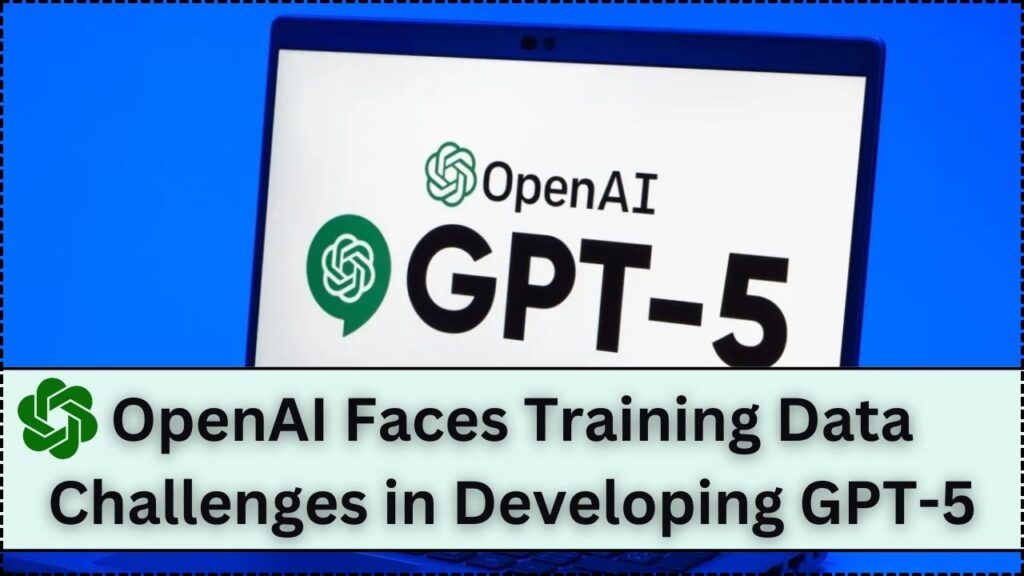
OpenAI Faces Training Data Challenges: Artificial intelligence has transformed countless industries, from healthcare to education. Leading the charge, OpenAI has consistently pushed boundaries with its advanced language models like GPT-4. However, the development of their next-generation AI, GPT-5, has hit a significant roadblock: a shortage of high-quality training data.
OpenAI Faces Training Data Challenges
| Topic | Details |
|---|---|
| Challenge | Scarcity of diverse and high-quality training data |
| Impact | Delays in GPT-5 development and increased costs |
| Estimated Training Cost | $500 million per run (source) |
| Current Strategies | Generating synthetic data and involving domain experts |
| New Innovations | Development of reasoning-focused models like the “o3” series (source) |
| Expected Release | GPT-5 unlikely to be launched in 2024 (source) |
The development of GPT-5 highlights both the potential and challenges of cutting-edge AI. While OpenAI faces significant hurdles—such as data scarcity and rising costs—their innovative solutions and commitment to quality continue to drive progress. In the meantime, users can benefit from improved reasoning models and refinements to existing tools like GPT-4.
Looking ahead, OpenAI’s focus on transparency, innovation, and collaboration with experts ensures that their AI systems remain at the forefront of technology. Although GPT-5’s release may be delayed, its eventual launch promises to set new benchmarks in AI capabilities.
Why Is GPT-5 Training Data So Important?
Training data is the backbone of AI models. For systems like GPT-5, it provides the vast knowledge needed to understand and generate human-like text. These datasets are typically drawn from diverse sources, such as books, articles, research papers, and public internet data. However, as OpenAI continues to scale its models, finding high-quality and diverse data is becoming increasingly challenging.
The Problem: Diminishing Returns from Internet Data
OpenAI’s researchers have found that the publicly available internet no longer offers the necessary variety or quality to meet the demands of training cutting-edge models. Most of the valuable data has already been used in prior versions, such as GPT-4. Reusing this data could lead to diminishing returns, where the model’s performance improvements plateau.
In addition, concerns about the ethical sourcing of data have prompted stricter guidelines on how information can be collected and used. OpenAI must navigate these constraints while trying to maintain the scale and diversity of their datasets. This adds another layer of complexity to the development process.
How OpenAI Is Tackling the Challenge in Developing GPT-5
To address this issue, OpenAI has adopted several innovative strategies:
1. Generating Synthetic Data
Synthetic data involves creating artificial datasets that mimic real-world information. For instance, OpenAI might:
- Simulate realistic conversations.
- Develop problem-solving scenarios in mathematics or coding.
Although promising, synthetic data generation is time-intensive and costly. It also risks embedding biases or inaccuracies if not carefully validated. OpenAI is employing advanced algorithms to monitor and refine the quality of this data, ensuring that it meets rigorous standards.
Moreover, synthetic data can fill gaps in specialized areas where public data is sparse. For example, simulating legal scenarios or rare medical cases can help GPT-5 provide better outputs in these domains.
2. Collaborating with Domain Experts
To ensure GPT-5 has access to specialized knowledge, OpenAI has begun working with experts in fields like:
- Software engineering: To enhance the model’s ability to write and debug code.
- Medicine and science: To improve its capacity for technical explanations and research support.
- Education: To help it provide clearer, more effective learning tools.
These experts create bespoke content tailored to training the AI, ensuring the inclusion of accurate and up-to-date information. By integrating human expertise, OpenAI aims to make GPT-5 a versatile tool capable of tackling real-world problems with greater accuracy.
3. Enhancing Reasoning Models
OpenAI is exploring a new class of models known as the “o3” series. These focus on reasoning and problem-solving rather than simply generating fluent text. By improving reasoning capabilities, OpenAI hopes to reduce issues like AI hallucinations (when the model generates false information).
The “o3” models are designed to analyze and validate their own outputs. This self-checking mechanism could help ensure GPT-5’s responses are both accurate and contextually relevant, making it more reliable for critical applications.
4. Expanding Data Sources
Beyond synthetic data and expert input, OpenAI is exploring unconventional data sources to enrich GPT-5’s training pool. This includes:
- Partnerships with educational institutions for access to academic research.
- Licensing agreements with publishers for exclusive datasets.
- User-contributed data, anonymized and ethically sourced.
These efforts aim to build a more robust and comprehensive dataset, paving the way for a truly next-generation AI model.
Why Is GPT-5 So Expensive?
Training advanced AI models requires immense computational power. Each training run for GPT-5 is estimated to cost $500 million. These costs arise from:
- Energy consumption: Massive GPU clusters operating around the clock.
- Specialized hardware: OpenAI relies on top-tier chips like NVIDIA’s A100 or H100 GPUs.
- Data preprocessing: Preparing high-quality datasets involves rigorous cleaning and annotation.
Moreover, the sheer scale of GPT-5’s parameters—expected to far exceed GPT-4—adds to the complexity and cost of training. OpenAI is also investing heavily in research to optimize these processes, seeking ways to reduce costs without compromising quality.
Despite these investments, OpenAI’s progress with GPT-5 has not yet achieved the revolutionary leaps expected, leading to delays and reevaluations.
Impact on Users and Industries of in OpenAI Training Data Challenges
What Does This Mean for Everyday Users?
While GPT-5’s delay might seem disappointing, it’s important to remember that GPT-4 and other existing tools remain highly capable. OpenAI continues to refine these systems, ensuring they meet user needs while addressing known limitations like occasional inaccuracies.
For example, GPT-4 has seen improvements in:
- Language understanding: Better comprehension of complex queries.
- Task execution: More accurate and reliable outputs.
- Creative applications: Enhanced ability to generate engaging content, from stories to marketing copy.
Implications for Professionals
Industries that rely on AI for automation and innovation—such as healthcare, legal, and technology—may need to wait longer for GPT-5’s groundbreaking features. However, ongoing improvements to existing models can still support tasks like:
- Drafting legal documents.
- Analyzing large datasets.
- Providing customer support at scale.
For professionals, the delay also underscores the importance of staying adaptable. By leveraging current tools and keeping abreast of emerging updates, they can continue to maximize the benefits of AI in their workflows.
FAQs About OpenAI Faces Training Data Challenges, in Developing GPT-5
1. Why is GPT-5 taking longer to develop?
GPT-5’s development is delayed due to a lack of sufficient high-quality training data, increased computational costs, and the need for more innovative techniques to achieve meaningful improvements.
2. When will GPT-5 be released?
OpenAI has confirmed that GPT-5 will not be ready in 2024. The company is focusing on refining existing technologies and exploring new approaches.
3. How can businesses prepare for GPT-5?
Businesses can:
- Continue leveraging GPT-4 and other tools for tasks like content creation and analysis.
- Stay updated on OpenAI’s progress.
- Invest in training staff to use AI effectively.
4. Are there alternatives to GPT-5?
Yes, many companies like Google (with Bard) and Anthropic (with Claude) are also developing advanced AI systems. These can serve as interim solutions for specific tasks.
5. How does OpenAI ensure ethical AI development?
OpenAI prioritizes transparency, fairness, and safety. They’re actively working on reducing biases in their models and ensuring outputs align with societal values.








